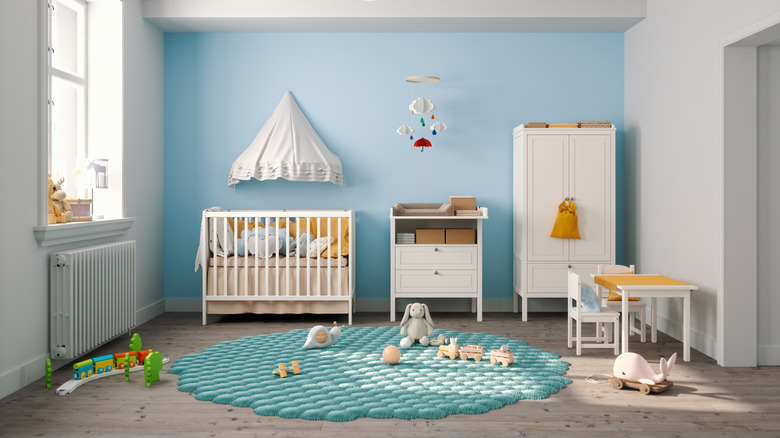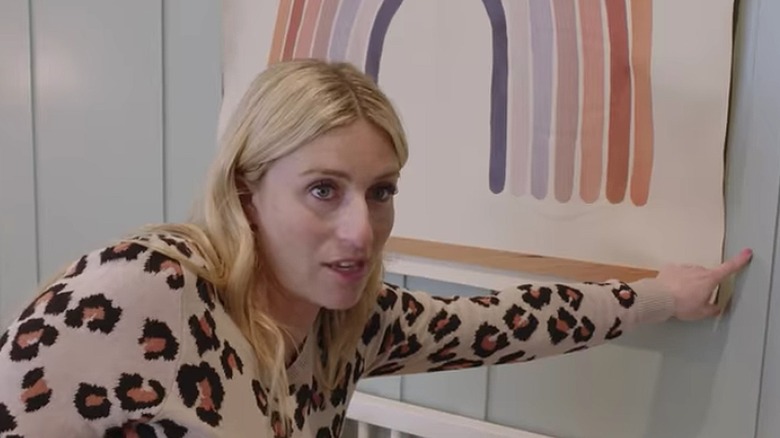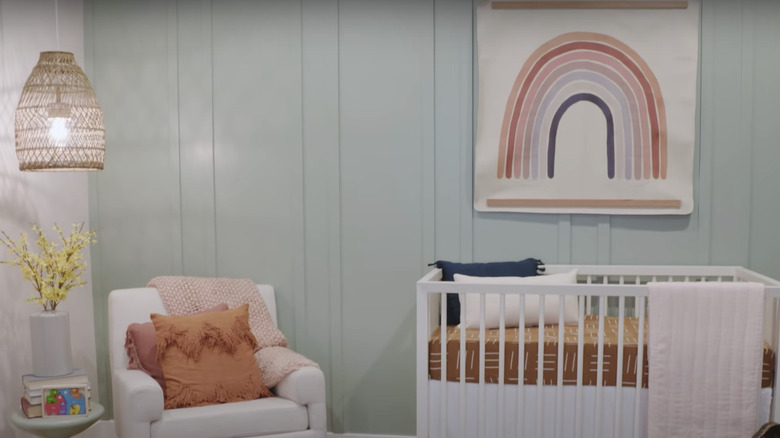Jasmine Roth Proves An Accent Wall Is The Stylish Addition Your Child's Nursery Needs
We may receive a commission on purchases made from links.
If you're expecting a bouncy new baby and you happen to be an interior design-loving DIYer, this could be a doubly exciting period. Parents-to-be, especially first-timers, are usually in deep prep mode. That could mean baby-proofing the house, reading baby books, and pulling together all the elements of a spectacular nursery. Besides picking out a crib and other furnishings, consider using even more of your creativity to create a stimulating environment for your baby. When she was expecting her child Hazel, builder, designer, and host of HGTV's "Help! I Wrecked My House" Jasmine Roth got inspired to create a stylish, textured accent wall using a beautiful medium sage-green color against a pale pink on the other walls (via YouTube).
You might know already that color schemes with dissimilar, contrasting tones help babies with their brain development, per Toll Brothers. So, creating a wall that contrasts with the rest of the walls can give your baby a mental boost. But if you choose a more muted difference between the accent wall and other walls, consider buying a mobile for the crib with black, white, and brightly colored objects to improve your newborn's vision. No matter the colors you go with, creating an accent wall will liven up the space and bring a rush of energy and new textures into the room.
Get started designing an accent wall for your nursery
An accent wall can be subtly or dramatically different from your other walls. Jasmine Roth included a texture of vertical panels made from medium-density fiberboard, or MDF, which is an engineered wood. As she says in the HGTV video, "On this wall, I actually added these strips of MDF ... but by painting it, it makes it feel like the whole wall was done in custom woodwork."
As you consider your design, is there a piece of art you feel especially connected to that you'll hang in your child's room? Maybe it contains a pattern or series of shapes you can replicate as a woodwork pattern on the wall. If not, what shape or silhouette do you find especially pleasing? Considering these questions will help you to design an accent wall that speaks to you.
Once you've decided on a 3D pattern for the accent wall, if you're using one, you'll need to install that first. One of the advantages of MDF is its flexibility; many shapes are possible so you can cut and sand it into the design you prefer. Usually, MDF comes pre-primed. Then you'll paint the whole wall and any moldings or shapes you've installed.
Choosing an accent color
To pick a color, pose a similar series of questions to refine your choices. How much light does the soon-to-be nursery get and from where? Southern and western exposures produce golden light, which means dark paint colors can seem brighter than expected, and light colors become radiant. Eastern-facing rooms get cooler-toned light where yellows, oranges, and reds might work well. Rooms facing north have indirect, very cool light where saturated colors can pop. If the nursery is tiny, you might want to keep the overall color palette lighter; dark colors make a room feel smaller.
Jasmine Roth chose Halcyon Green from Sherwin-Williams for the accent wall and Faint Coral for the other walls, also from Sherwin-Williams. Describing how she came up with her strategy, she says, "If the whole room was painted this dark sea-foam green color, I think it would be too much. Just like if the whole room was painted pink, I think the pink wouldn't have as much of an impact ... together, they really play nicely."
For an accent wall, consider a soft buttercream-yellow shade called Moonlight from Benjamin Moore ($80/gallon at the time of writing). Oceanic Teal from Creative Paint ($58/gallon) is bold but not too out there since it's muted with a slight gray undertone. Tranquil Pond from Behr ($24/gallon) is a calm blue-gray with a noticeably purple vibe. You may need less than a gallon, which covers about 400 square feet. For the other walls, white, soft white, or a light clay color could work.


